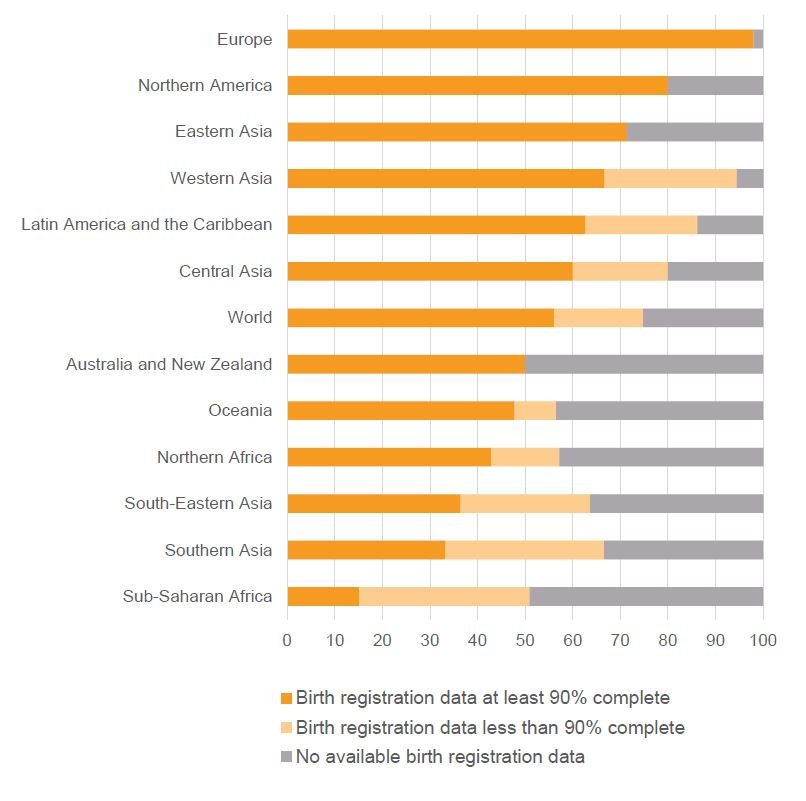Digital civil registration and legal identity systems: A joined-up approach to leave no one behind: Chapter 1
Introduction
DownloadsCivil registration, legal identity as well as the production and use of vital statistics are fundamental to achieving the Sustainable Development Goals (SDGs) by 2030. There are discrete targets on registration (SDG 16.9: “to provide legal identity for all, including birth registration” and SDG 17.19.2: “to have achieved 100% birth registration and 80% death registration”). Many other goals will be impossible to monitor or meet without complete population data. But most importantly, the overarching pledge of Agenda 2030 that no one should be left behind, depends on counting all people. Without data on the whole population, it is not possible to know who is missing out on services or to target policies and resources effectively.
Figure 1: Completeness of birth registration data by region (%)

Birth registration completeness is greatest in Europe. Southern Asia and Sub-Saharan Africa see the lowest levels of birth registration completeness.
Note: Based on 2015 data. Oceania excludes Australia and New Zealand.
Source: United Nations, 2017. Progress towards the Sustainable Development Goals: report of the Secretary-General – supplementary information. September 2017. Available at: https://unstats.un.org/sdgs/files/report/2017/secretary-general-sdg-report-2017--Statistical-Annex.pdf
Over the last few years, the attention of governments in developing countries has increasingly been focused on the administrative challenges posed by their commitment to leave no one behind. As indicated in Figure 1, the global statistics on birth registration are stark: one billion people cannot prove their legal identity; [1] a quarter of children under the age of five have no form of birth registration; [2] and half of the population of Africa is not registered at birth. [3]
International responses such as the UN Global Civil Registration and Vital Statistics Group [4] , the Africa Programme on Accelerated Improvement of Civil Registration and Vital Statistics (APAI-CRVS) [5] , the World Bank’s ID4D Initiative [6] and the Canadian-led Centre of Excellence for CRVS Systems [7] have stepped up their efforts to support national programmes to improve CRVS and ID systems.
This report aims to support and complement these efforts by focusing on three key areas.
Chapter 2 explores trends in birth registration to identify populations at risk of being left behind. Aggregate global estimates are not always the best vehicle for understanding problems. This report explores trends in coverage of birth registration for those living in the poorest 20% of households in the population. The gaps in household survey data on civil registration and vital statistics (CRVS) are highlighted to show where better data on implementation of CRVS is needed.
Chapter 3 examines progress towards digitising CRVS. For birth registration to empower everyone, including the dispossessed, to access the services they are entitled to there is a need for digital connectivity between registration and service provider systems.
Chapter 4 shares a new framework to monitor the global commitment to universal civil registration and legal identity. This proposal complements the data from household surveys and empowers national statistics offices to maintain ownership and accountability for the monitoring process. The chapter concludes by focusing on how CRVS systems should be linked to service delivery in order to empower those most at risk of being left behind.
Downloads
Notes
-
1
Desai, V., Diofasi, A. and Lu, J., 2018. The global identification challenge: Who are the 1 billion people without proof of identity? World Bank Blogs, [web blog], 25 April 2018, https://blogs.worldbank.org/voices/global-identification-challenge-who-are-1-billion-people-without-proof-identity (accessed 16 March 2020)Return to source text
-
2
UNICEF, Birth registration data, https://data.unicef.org/topic/child-protection/birth-registration/ (accessed 16 March 2020)Return to source text
-
3
Chinganya, C., 2019. Speech at the 5th Conference of Africa Ministers responsible for Civil Registration, Expert Group Meeting, Lusaka, Zambia. 14 October 2019. Available at: https://au.int/en/speeches/20191014/5th-conference-africa-ministers-responsible-civil-registration-speech-oliverReturn to source text
-
4
UN Global Civil Registration and Vital Statistics Group, https://unstats.un.org/unsd/demographic/crvs/globalcrvs.html (accessed 16 March 2020)Return to source text
-
5
Africa Programme on Accelerated Improvement of Civil Registration and Vital Statistics (APAI-CRVS), http://www.apai-crvs.org/about-apai (accessed 16 March 2020)Return to source text